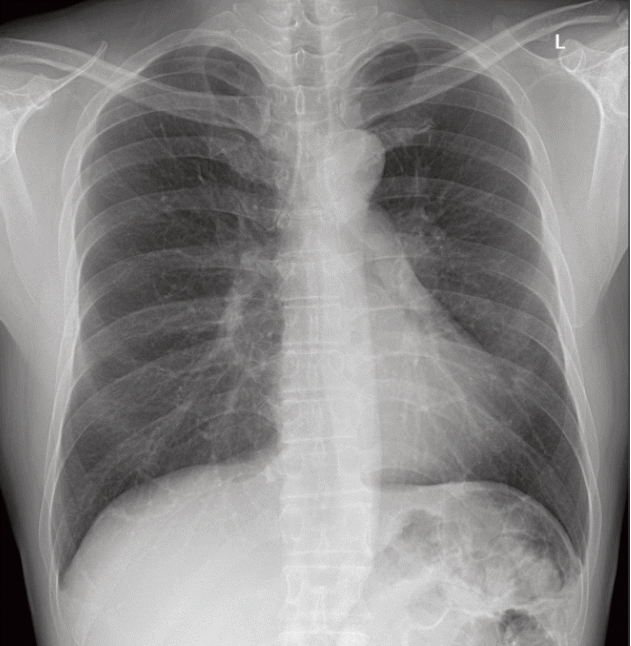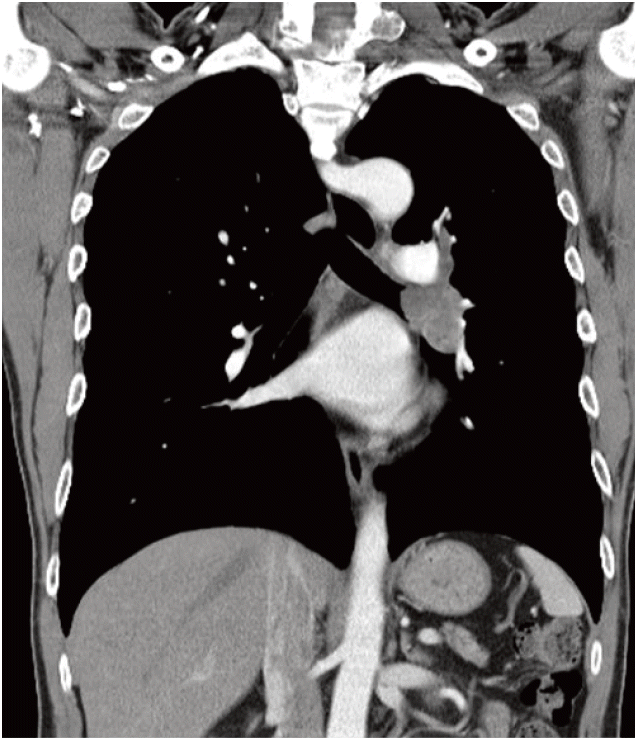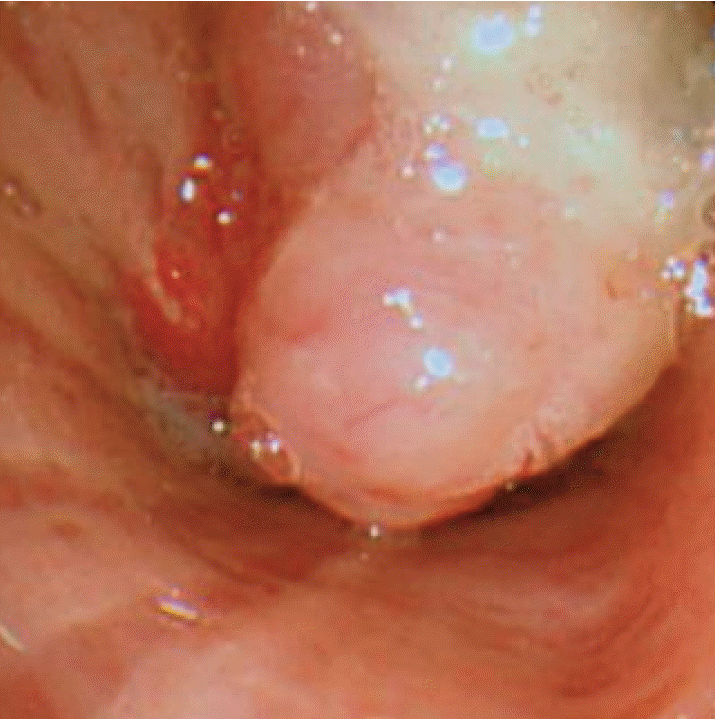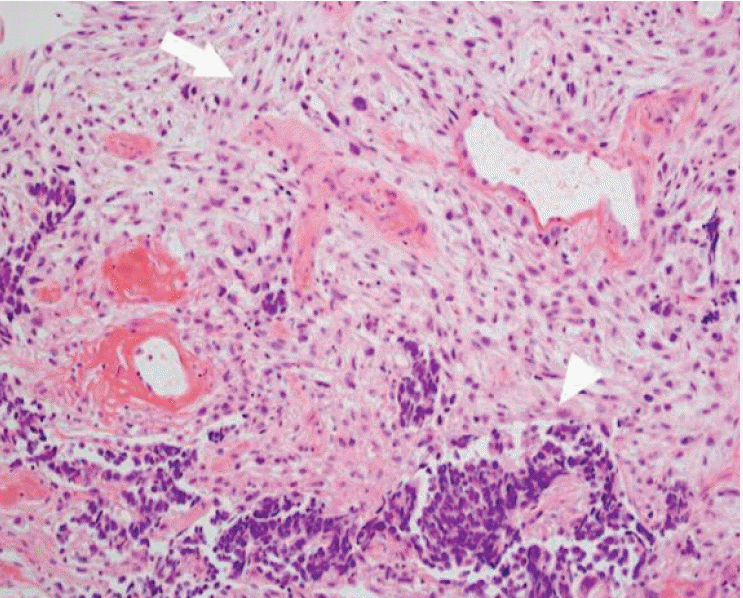Introduction
Bronchopulmonary carcinosarcoma is a rare malignancy accounting for less than 0.2% to 0.3% of bronchopulmonary tumors. It has admixed components of both malignant epithelial and mesenchymal elements (carcinomatous parenchyma and sarcomatous stroma) [1]. Compared to conventional chest radiography, tomosynthesis is a more sensitive and accurate diagnostic method with a relatively lower radiation dose. Tomosynthesis can provide stereoscopic images and remove the shadows of bones and overlying structures, giving superior visibility of lesions that are difficult to be recognized on chest radiography. We present the first case in which digital tomosynthesis (DTS) was useful for the evaluation of airway obstruction by bronchial carcinosarcoma that was overlooked on initial chest radiography.
Case Report
A 45-year-old male construction worker for a fire extinguishing facility was admitted to our hospital with a 3-month history of NYHA class II dyspnea. He had previously never been hospitalized and had no underlying disease.
The physician performing the physical examination noticed a wheezing sound on auscultation when the patient breathed. The patient underwent routine chest radiography (Fig. 1). However, we did not detect the airway obstruction on chest radiography at a glance. Suspicious of airway obstruction, we recognized the focally-narrowed left main bronchus. Thus, we recommended DTS for evaluation of the airways. The patient underwent DTS (VolumeRAD, GE Healthcare, Chalfont St. Giles, UK) with flat panel detector radiography (Definium 8000, GE Healthcare) as a follow-up (Fig. 2A).
DTS revealed that a lobulating contoured endobronchial lesion nearly obstructed the left main bronchus. Furthermore, we could examine the extent and margins of the endobronchial tumor on anterior-to-posterior coronal images from the DTS (Fig. 2B). After the recognition of the endobronchial mass, the patient underwent computed tomography (CT) scanning for further evaluation. On the CT images, a mildly enhanced finger-like lesion was observed along the left main bronchus and upper lobar bronchus extending to the left lower lobar bronchus (Fig. 3), as suspected on DTS. Subsequent bronchoscopy revealed a mass lesion almost completely occluding the left main bronchus at a site 4 cm below the carina and protruding to the endobronchial space (Fig. 4). A biopsy of the tumor was performed during bronchoscopy and showed that the tumor was composed of epithelial carcinoma that was poorly differentiated, as well as a sarcomatoid component. Positron emission tomography-CT also showed the hypermetabolic status of the lesion and the hilar lymph node, suggesting a malignant process. Surgical procedures were determined based on the evidence presented above. In the surgical field, the main portion of the mass lesion was located in the left main bronchus and left upper lobar bronchus, and a partial portion was located in left lower lobar bronchus. The lesion extended toward the right opposite border of the superior segment of the left lower lobe, so the surgeon performed a left pneumonectomy and mediastinal lymph node dissection. The tumor was 2.5×2 cm and was composed of neuroendocrine carcinoma, adenocarcinoma, squamous cell carcinoma, and sarcoma (Fig. 5). Lymph node metastasis was also reported. The patient did not suffer from any major complications and was put on adjuvant chemotherapy with Genexol and cisplatin.
Discussion
Bronchopulmonary carcinosarcoma is a rare malignancy that presents as a peripheral solid mass or a central endobronchial lesion. The incidence of the tumor is not fully known due to its rarity, although a few studies have reported that a peripheral type of the carcinosarcoma was found in 62% to 85.7% of total bronchopulmonary carcinosarcomas [2].
Although conventional chest radiography remains in use for the initial imaging of diseases of the chest, it provides poor information for screening the tracheobronchial tree. In the evaluation of tracheobronchial disease, chest radiography is inferior to CT in terms of detection, localization, extent, characterization, and overall information [3]. DTS is a new X-ray application that provides multiple high-resolution slice images of human anatomy including the chest and tracheobronchial tree, while providing more information than radiography and lower radiation doses than CT [4,5]. Airway evaluation by DTS has not yet been reported.
DTS is a refinement of conventional geometric tomography that has been known since the 1930s. DTS acquisition lasts 10 seconds and is comprised of 60 low-dose projections using a tube voltage of 100 kVp, a 1:5 dose ratio, and a 0.3-mm additional Cu filter. The detector is fixed in the standard orthogonal posteroanterior position while the X-ray tube undergoes vertical continuous movement from –17.58° to 17.58°. The 60 projection images obtained are used for the reconstruction of approximately 54 coronal images with a nominal thickness of 4-mm without overlap [5]. The recently reported conversion factor of chest tomosynthesis is 0.26 mSy/Gy/cm2, and dose-area product is 67.45 uGym2 in our case, so the effective dose in our case is 0.18 mSv [6]. The usual effective dose of chest tomosynthesis is 0.12 mSv in the literature, that of chest PA is 0.04 mSv, and that of chest CT is 4 mSv [7]. Thus, the effective dose of DTS is three times more than that of chest X-ray, but 30 times less than that of chest CT scan.
Previous reports on bronchopulmonary carcinosarcoma have investigated its features on imaging or its pathologic findings [8-10]. This case is the first to demonstrate bronchial carcinosarcoma by chest tomosynthesis in the evaluation of an endobronchial lesion that was overlooked on the initial chest radiography in a patient presenting with wheezing. Based on this case, we suggest that endobronchial tumors can be assessed and evaluated by tomosynthesis when there is suspicion of a bronchial problem. Tomosynthesis for the evaluation of airway obstruction can achieve more sensitive detection of endobronchial lesions that may be overlooked on chest radiography, even with low radiation doses compared with CT. This can provide more accurate information than serial follow-up chest radiography for patients with airway obstructive lesions, such as central lung cancer, and can serve as a short-term follow-up modality between relatively long-term CT scans during chemotherapy. The continuous anterior-to-posterior coronal images obtained by DTS can also provide information on the 3-dimensional relationship between the lesion and the bronchial tree, which can give clinicians and surgeons insight into the status of the lesion with low dose radiation.
In conclusion, tomosynthesis can be a modality for the evaluation of airway lesions, providing spatial relationship information with lower radiation doses than ever before.
















